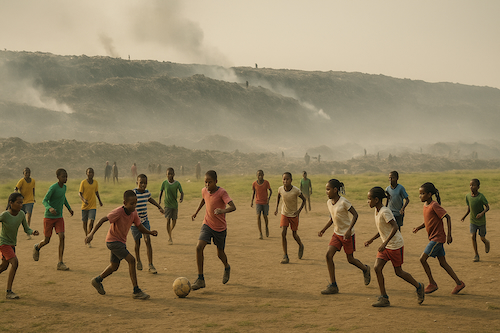Children of Korogocho | Audio
We have launched an information channel on YouTube called Korogocho Hub. It provides information about the slum in audio and video format. It covers topics such as the children of Korogocho, the living conditions of slum dwellers and many other issues, including education, nutrition and disabled slum dwellers.
Up to 45% in Korogocho are Children
Korogocho, located in the east of Nairobi, is the third largest slum in the Kenyan capital. The name comes from the Kikuyu language and means “chaos” or “confusion” – an apt description of the dense, chaotic life on just under one and a half square kilometres. Up to 200,000 people are crammed into this small area, many without access to clean water, reliable electricity or medical care. Most residents work in the informal sector, earning just enough to survive through odd jobs or trade.
The high proportion of young people is striking. Around 35 to 45 per cent of Korogocho’s inhabitants are children under the age of 18 – that is, about one-third to almost half of the total population. Many of these children grow up in precarious conditions, often in corrugated iron huts without adequate ventilation, with shared latrines and limited access to schools. The Dandora landfill, one of the largest in Africa, is also located in the immediate vicinity. Every day, children search there for recyclable materials to support their families financially.
An ambivalent picture remains
Despite these extreme conditions, there are also signs of solidarity in Korogocho. Local initiatives and church groups offer care and education programmes to integrate at least some of the children into safe daily structures. They try to create a place where hope can grow – in the middle of a neighbourhood otherwise characterised by the daily struggle for survival. But the picture remains ambivalent: Korogocho is a place of poverty, but also a place of resilience, where a young generation is growing up that strives for a better life despite the most adverse circumstances.
Deutsche Zusammenfassung
Korogocho im Osten Nairobis ist extrem dicht bewohnt; bis zu 200.000 Menschen leben auf 1,5 km², davon rund 35–45 % Kinder. Viele wachsen in Wellblechhütten mit schlechten Sanitärverhältnissen auf, haben wenig Zugang zu Schule und medizinischer Versorgung und arbeiten nahe der Dandora-Deponie, wo sie verwertbares Material sammeln – oft gesundheitsschädlich. Lokale Initiativen und kirchliche Gruppen bieten Betreuung und Lernangebote und schaffen sichere Anlaufstellen. Zwischen harter Armut und Risiko zeigt sich dennoch eine bemerkenswerte Widerstandskraft der Kinder.










